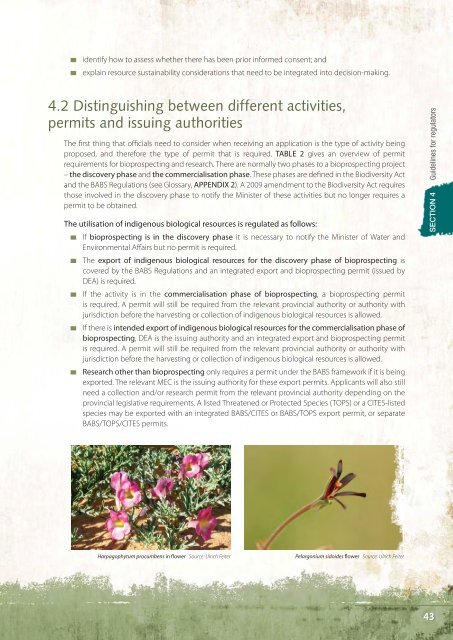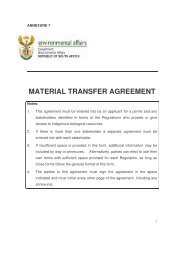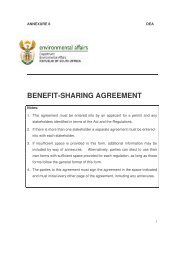South Africa's Bioprospecting, Access and Benefit-Sharing ...
South Africa's Bioprospecting, Access and Benefit-Sharing ...
South Africa's Bioprospecting, Access and Benefit-Sharing ...
Create successful ePaper yourself
Turn your PDF publications into a flip-book with our unique Google optimized e-Paper software.
identify how to assess whether there has been prior informed consent; <strong>and</strong><br />
explain resource sustainability considerations that need to be integrated into decision-making.<br />
4.2 Distinguishing between different activities,<br />
permits <strong>and</strong> issuing authorities<br />
The first thing that officials need to consider when receiving an application is the type of activity being<br />
proposed, <strong>and</strong> therefore the type of permit that is required. TABLE 2 gives an overview of permit<br />
requirements for bioprospecting <strong>and</strong> research. There are normally two phases to a bioprospecting project<br />
– the discovery phase <strong>and</strong> the commercialisation phase. These phases are defined in the Biodiversity Act<br />
<strong>and</strong> the BABS Regulations (see Glossary, APPENDIX 2). A 2009 amendment to the Biodiversity Act requires<br />
those involved in the discovery phase to notify the Minister of these activities but no longer requires a<br />
permit to be obtained.<br />
The utilisation of indigenous biological resources is regulated as follows:<br />
If bioprospecting is in the discovery phase it is necessary to notify the Minister of Water <strong>and</strong><br />
Environmental Affairs but no permit is required.<br />
The export of indigenous biological resources for the discovery phase of bioprospecting is<br />
covered by the BABS Regulations <strong>and</strong> an integrated export <strong>and</strong> bioprospecting permit (issued by<br />
DEA) is required.<br />
If the activity is in the commercialisation phase of bioprospecting, a bioprospecting permit<br />
is required. A permit will still be required from the relevant provincial authority or authority with<br />
jurisdiction before the harvesting or collection of indigenous biological resources is allowed.<br />
If there is intended export of indigenous biological resources for the commercialisation phase of<br />
bioprospecting, DEA is the issuing authority <strong>and</strong> an integrated export <strong>and</strong> bioprospecting permit<br />
is required. A permit will still be required from the relevant provincial authority or authority with<br />
jurisdiction before the harvesting or collection of indigenous biological resources is allowed.<br />
Research other than bioprospecting only requires a permit under the BABS framework if it is being<br />
exported. The relevant MEC is the issuing authority for these export permits. Applicants will also still<br />
need a collection <strong>and</strong>/or research permit from the relevant provincial authority depending on the<br />
provincial legislative requirements. A listed Threatened or Protected Species (TOPS) or a CITES-listed<br />
species may be exported with an integrated BABS/CITES or BABS/TOPS export permit, or separate<br />
BABS/TOPS/CITES permits.<br />
Guidelines for regulators<br />
SECTION 4<br />
Harpagophytum procumbens in flower Source: Ulrich Feiter<br />
Pelargonium sidoides flower Source: Ulrich Feiter<br />
43






![Innovation at UCT 2010 [Report] - Research Contracts & IP Services](https://img.yumpu.com/28928393/1/184x260/innovation-at-uct-2010-report-research-contracts-ip-services.jpg?quality=85)